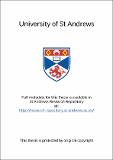Files in this item
Vocal learning in the grey seal, (Halichoerus grypus) : an experimental approach
Item metadata
| dc.contributor.advisor | Slater, P. J. B. (Peter James Bramwell), 1942- | en |
| dc.contributor.author | Shapiro, Ari | en |
| dc.coverage.spatial | 115 p | en |
| dc.date.accessioned | 2021-04-08T08:59:20Z | |
| dc.date.available | 2021-04-08T08:59:20Z | |
| dc.date.issued | 2003 | |
| dc.identifier.uri | https://hdl.handle.net/10023/21906 | |
| dc.description.abstract | This thesis presents a series of training experiments on three captive grey seal (Halichoerus grypus) pups in an effort to demonstrate vocal learning, the modifying of vocalisations in form due to experiences with those of other individuals. One pup was non-vocal but participated in four experiments in which her responses to centre and off-centre pointing gestures and directional cues to laterally and centrally-placed objects were investigated. She oriented successfully only towards laterally-positioned objects indicated by centre and off centre pointing, pointing and head turning, and upper body turning. These results and her failure to follow pointing gestures towards an object located centrally behind her suggested she simply advanced in the direction of movement of the experimenter, stopping once she located an object. The other two pups were trained to vocalise when presented with a light and to remain silent otherwise and subsequently to match a total of nine moan and growl playbacks with vocalisations of the same type. Twelve novel moan and growl playback stimuli were then used, but these primarily elicited growls as responses. The animals failed to generalise the matching of vocal category, revealing they had been trained only to respond correctly and specifically to the nine original playbacks. These results demonstrated a capacity for contextual learning in which experience with the training procedure caused the pups to pair their production of particular vocalisations with new contexts (i.e. a light and specific playback stimuli). Lastly, one of these pups was trained to produce moans that had fundamental frequencies below 250 Hz. A comparison before and after the training protocol demonstrated that his responses had become both significantly lower and longer. Maturation was not responsible for this result since this pup continued to produce higher-pitched moans in non-experimental contexts. His control over the vocal apparatus to make these frequency and temporal adjustments represents an initial step in establishing whether grey seals are capable of vocal learning. Further studies are required to determine whether additional control over vocal production is possible in this and other pinniped species. | en |
| dc.language.iso | en | en |
| dc.publisher | University of St Andrews | en |
| dc.subject.lcc | QL737.P64S2 | |
| dc.subject.lcsh | Gray seal--Behavior | en |
| dc.subject.lcsh | Animal communication | en |
| dc.title | Vocal learning in the grey seal, (Halichoerus grypus) : an experimental approach | en |
| dc.type | Thesis | en |
| dc.type.qualificationlevel | Doctoral | en |
| dc.type.qualificationname | MPhil Master of Philosophy | en |
| dc.publisher.institution | The University of St Andrews | en |
This item appears in the following Collection(s)
Items in the St Andrews Research Repository are protected by copyright, with all rights reserved, unless otherwise indicated.

